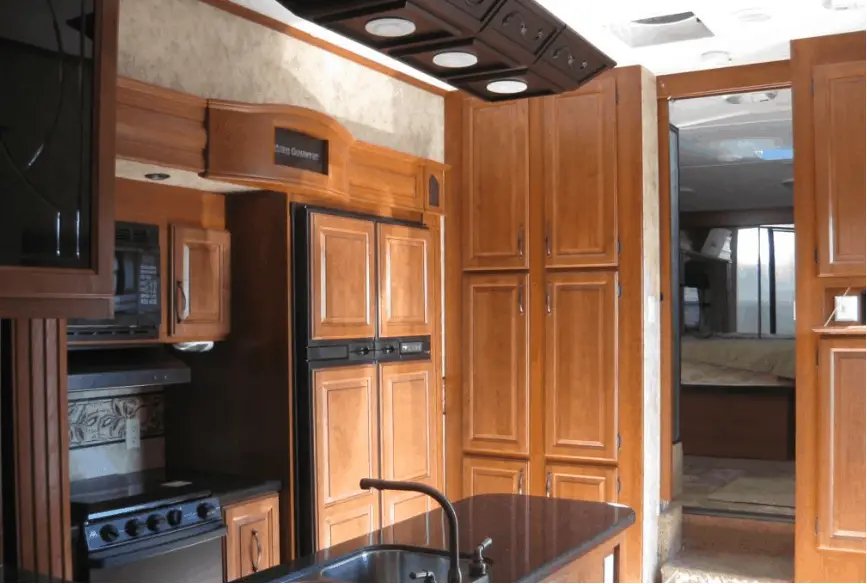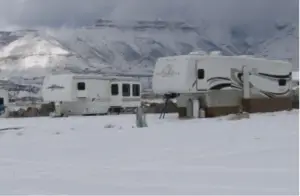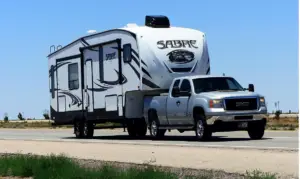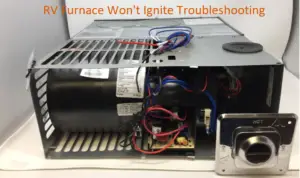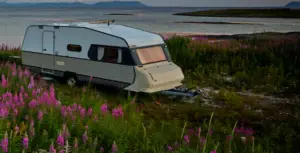Are you seeing a lot of power or energy wastage happening in your RV? Also, the utilities cost are shooting up? If yes, then this piece of article is specially for you looking to make your RV more energy efficient.
Living full time in RV needs proper planning and its always better to have budget for everything. While in RV, you would be using appliances and gadgets that will need power to run.
Your sources of power or energy in the RV can be generator, DC battery, propane or solar while dry camping or boondocking. At the campground, you will get the electricity hookup.
The energy usage is a major part of your spending when you are living full time or even when you are living in it for extended period of days. Some people live in RVs for weeks or even months.
In this article, we will see different ways how you can make your RV more energy efficient. Also, how you can reduce the power or propane consumption in the camper.
Average Electricity Usage
Before we get started with the tips on how to make your RV more energy efficient, it is best to give you some idea of the cost for the electricity your RV uses. Keep in mind we are only talking average costs here.
Some RVs use more electricity while others use less. Plus, not all RVs are filled with large families so individual use will be below the average figures provided here.
The average RV uses about 20 kWh every day and that equals 608 kWh (30 x 20) every month. If you used your RV for a year you can expect to use about 7,300 kWh (12 x 608).
Each state charges different rates with Hawaii being the highest at 26 cents per kWh and Louisiana the lowest at 7.75 cents per kWh.
So multiply the 20, the 608 and the 7,300 kWh by the national average of 10.54 cents per kWh and you will see how much electricity your RV uses on average.
The usage will vary depending on the climate. Like for example, if its summer then your Ac would consume a lot as compared to winter. Similarly, if the climate is very cold then the furnace will run lot longer and the consumption will be higher.
Lets start with tips to make your RV energy efficient.
Install Solar Panel
Solar power can help cut the amount of energy your RV uses. It provides a way to run your rig’s appliances and lights, etc., without having to worry about paying hook up fees. Plus, you can recharge your batteries through solar power.
Its Free : Then the sunlight is always free, just park in a position that maximizes the sunlight and keeps your rig heated.
Great thing with solar is you only need a single time effort in getting it up there on the roof. From there on, its going to be minimum efforts. Yes, for better utilization you may also want to have it facilitate tilting or even placing it on the ground.
We have solar panels placed on the roof that have brackets which allow tilting them as per sun directions. It hardly takes us 10-15 minutes to do this. Getting a separate folding panel to place on the ground also helps in maximizing the overall utilization.
Solar kits like the one made by Renogy are easy to install. The whole system assembly can be set up easily.
If you are going to buy the components separately then the cost will be less. But, getting the kit as a whole is better as you don’t have to put much effort to set it up.
Aren’t sure on how to get the solar up and running? Here is a detailed article that i had posted previously on setting up solar for boondocking in RV.
Use Insulation
Insulation in many RVs, especially the older models is not that good. You can add more or replace old insulation that is too worn out to do a good job.
Check your current insulation to see if it meets proper energy-efficient levels and take the appropriate action if it isn’t. Better insulation is a best tip that can save you a lot on electricity. Also, you need insulation for both winter as well as summer.
Read : Preparing your RV for winter cold
Also, you can add insulation under your RV’s flooring. This has to be done from beneath the rig but it is time well spent.
Insulating the windows, underbelly or ceiling will only help in making the RV more efficient in winter as well as in summer. Furnace will need more propane if the space inside isn’t properly insulated.
Same goes with AC, if there are leaks or gaps then the efforts needed by AC will be much higher. This will obviously lead to higher energy consumption.
New vs Old rig : If you are the proud owner of a new modern RV then it will be properly insulated and you will not need much efforts. With older rig you may need to get all these things done with extra efforts.
You can make use of wool or fiber as insulation. Identify the heat loss areas and get them insulated. Windows, door gaps or storage compartments can have such leaks.
| Insulation Type | Pros | Cons |
| Rigid Foam | 1. Long lasting 2. Moisture resistant | 1. R-Value not very good 2. Little hard on installation |
| Spray Foam | 1. Less weighing 2. Cheap | 1. Difficulty in installation 2. Low R-value |
| Fiberglass | 1. Less costly 2. Easy to install 3. High R-Value | 1.Not great in moisture |
Make use of reflectix. There are different types of reflective materials or covers available but reflectix is a product that is more popular among RVers.
It is a polythylene wrapped in a reflecting aluminum foil. Its a bubble wrap that gives strength for supporting and also provides air spaced insulation.
Reflectix is really an amazing product that can give better insulation and is easily available on amazon or home depot stores.
Another good thing about reflectix is you can use it to insulate various appliances or components on the RV. You can insulate your water heater to your kitchen items.
You can cut it based on where you want it to go. A small normal scissor is enough to cut it, but its better to mark the shape before going ahead with cutting it.
Windows, door gaps ceiling vents, underbelly; it can be fixed wherever you want. That is what makes it much better product to use.
Seal Air Leaks
These can be found in several places. Your vents are a common problem. You can stuff pillows in the vents or re-caulk them to cut down leaks. Or check your windows to see if they have doubled pane or not or have holes in the caulking.
Re-caulk the windows or replace the single pane style with double panes. Look for leaks around air conditioner seals.
Well insulated RV will see much less air leaks. You air conditioner goes at the top of the RV and there will be seams around the screws, make sure it isn’t leaking air inside.
Use RV putty sealing tape for vents on the roof or door. Eternabond seal can also be sued to get the seals done.
Regular maintenance like this one needs a little spending but it helps in reducing the overall cost it takes to live in an RV.
Make Use Of Skirting
Part of the RV energy efficiency problem is that there is too much airflow beneath your rig. That airflow can keep your interior a lot cooler than it should be.
To stop this from taking place, you can place skirting around your rig adding an extra layer of insulation.
RV skirt can be made of materials like vinyl, plywood, tarps, foam boards or styrofoam.
Each of these materials have varying properties. A plywood is sturdy and less costly where as tarps are not that great in terms of durability. They can be easily teared off. Vinyl too is strong and cannot tear easily.
Point is, you need to select the skirting material depending on RV type and what kind of weather you are in.
No mater what type of material you choose, the skirting is definitely going to keep your RV warm. This in turn will help the purpose of saving on energy. A warm RV means you will be employing less power on furnace, heater or other methods.
Increase RV furnace efficiency
You can live with a space heater when the temperature isn’t that low. But, for sub zero degrees and even during nights, the space heater may not be the best option.
A furnace not only keeps you warm and cozy but also protects other items or parts in the RV.
A running furnace will keep the pipelines warms and prevent them from freezing. Overall temperature of your rig comes up with an operating furnace.
Furnace operates on propane and will also need 12V battery. Propane consumption can be high if the furnace isn’t operating at its max efficiency. So, how do you get it working efficiently? Read on to find out:
- Do not restrict the furnace airflow. Make sure the compartment is clear at-least few inches. Do not store other items that will block its way.
- Make sure the furnace is clean. Vacuum it occasionally to make sure dust, dirt is removed.
- Look for smells and take action. The smells could be due to insects or wasps getting into it through the vents. Cover the vents when not in use, this will block flying insects from getting into the furnace.
- Take the furnace to the technician as soon as you see soot.
These few things can help operate the furnace at optimum efficiency saving on propane. Further reading on watts consumption by furnace in rv.
Cook Outdoors
There is nothing like a meal cooked over an open fire. Not only do you get better meals, but you also help your RV stay cooler and use less energy to keep itself cool.
This applies to any heat-producing appliance. The cooler you keep your RV’s interior the less energy it will use for AC.
Try Outdoor grilling or barbecue when you have outdoor area available. While boondocking, we do a lot of outdoor cooking and it is also an amazing way to get out of your RV. This method will surely bring your overall utilities cost down.
Park RV In Shade
This is one of the easy options to keep you rv cool in summer. It is free and it helps keep your RV nice and cool before the heat of the day finally reaches your rig. The shade helps your air conditioner be more efficient and helps your fridge work less hard.
There are many other things you can do to keep your RV cool without an air conditioner.
Increase RV refrigerator efficiency
RV camping in Summer is fun and a lot of people head-out during these times. Refrigerators in your RV however may not be operating at optimum level during these times.
You may see its taking longer for them to cool or they may not reach that level of cooling.
Don’t worry it does not mean the fridge is broken. Its just the extra heat that is making it run that way or its efficiency is reduced.
On an average a standard RV refrigerator would consume around 150-180 watts for running. The starting watts are on higher side to around 500 -600 watts.
Remember the fridge would be running all the time so its always better to have it operating at maximum efficiency.
Unlike air conditioner it will be ON 24 hours but its worth to note that it wont consume much when its already cold and the door is closed. Defrosting the refrigerator consumes much more energy than starting or operating.
So, how to make it function more effectively? Here are some tips to try.
- Make use of evaporator fan inside the fridge. The air produced by the fan will circulate it inside the fridge, keeping it cool.
- Do not over pack the fridge. Keep some space for air circulation, this will allow it to operate better and cool faster.
- Control on the amount time you keep opening that door. The more time it remains open, more energy it will utilize to make itself colder.
- Level the RV. This is one of the major reasons why RV’s need to be leveled. Fridge can malfunction when the RV is not leveled.
Insulate Your Water Lines
Cold water makes your water heater burn more energy to heat it up to where you want it. Wrapping the water lines keeps the water from getting too cold and allows the water heater to work less when it has to warm it up.
Keeping the water line warms is a must step if you are in a sub zero regions. So, be sure to implement this or face the freezing of pipes as well.
Cut On Parasitic Loads
This means identify all the appliances or items that remain ON but don’t necessarily serve any major purpose. This normally happens with your DC battery. Although there may not be major power leakage due to this, but still it will save on some power for sure.
Lights in storage compartment, solar controller, other ceiling or wall lights, it could be any of the those small items that can draw from your source. Also, be sure to turn off the appliances that are ON due to negligence.
A ceiling mounted fan or again lights that remain ON for no purpose should be turned off. We do this all the time. These little things do matter when considered as a whole.
Add Awnings Or Screen Room
These can be added if your budget allows. Awnings are great as they help keep the sun’s rays from overheating your RV’s interior. That helps your air conditioner cut down on its workload.
Or if your budget doesn’t allow for awnings, try UV reflective screening. This screening can be used in different ways and help protect your RV from the sun’s heat.
Having an awning specially when you are boondocking adds a different feel to your setup. It not only provides some shade but also gives you that extra space to relax. A screen room in addition to awing will take to next level.
Screen room keeps the insects, bugs away and also protect against the sun. Plus it adds privacy as well. I was unaware of this idea initially. Its a great way to increase the livable area in RV.
So, how is this an energy efficient tip? Well, you will be protecting the RV from sunlight so lesser use of air conditioner. Overall the rig will be less heated from sun and therefore less energy used in running the AC.
Paint The Roof On Your RV
Reflective paint is available and it is made in different varieties to cover plastic, rubber, or metal roofs. This paint will help redirect the sun’s rays and allow your air-con and fridge to work at more efficient levels.
Make Sure Air Conditioner is Running Efficiently
If your RV is more than 10 years old, you should replace the air conditioning unit with one that is technologically up to date and more energy efficient.
The cost may be large now but over the long haul, you should recoup your payment with your energy savings. Before you get that new one be sure you have already optimized the existing ac for better efficiency.
Improve RV AC efficiency
AC is the highest watts consuming appliances in the RV. On an average a 15,000 BTU AC runs at 1500 watts and needs 3200 watts to start. Doing below simple things can increase its efficiency and reduce the power consumption.
- Make use of power vents. Non Ducted AC’s have less air cooling as compared to Ducted one. Install a vent at the bottom of the AC. You can get those small vents from amazon. Its a DIY project. Check out the differences here.
- Clean the AC vents and make sure there isn’t any dust or dirt accumulated. This reduces the air flow.
- Maintain it periodically. It needs that once in a while maintenance just like other appliances.
In Conclusion
Figure out what you will need and what works best for you. It also may be time to trade that old RV in for a newer used model.
That upgrade will help you be more energy efficient on your next RV vacation. Go with the simplest fixes first, then see if you need to do any major repairs. I am sure these tips will surely bring down the amount you spend on RV energy consumption per month

